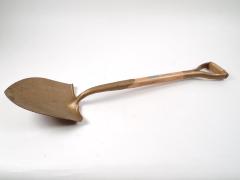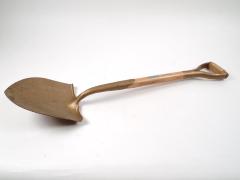Comments and Tags
Be the first to comment on this item!
Military and Veterans ➔ Back Pack
Identifier:
1984.48.121Description:
This backpack is a significant piece in the collection both for its connection to the Grand Rapids furniture industry and to the experience of veterans. This model of backpack was made by American Seating, a furniture company with Grand Rapids roots from 1886, as part of the War effort. From 1941 American Seating Company increasingly focused production on military products with 90% of their goods supporting the US Military in 1944.This backpack has a wooden outside shell/frame with canvas inside back and straps. It was a US Army multi-purpose backpack that sources suggest was used to carry items such as radios, ammo boxes and artillery rounds. Numerous hooks are on the sides and tied ropes appear to allow for flexibility in usage. The outside of the hard shell is embossed with US. It is also stamped on the inside with the manufacturers name, what is likely the model or part number, and date of production:
“AMERICAN SEATING CO.
0.1.7825-4X-C
3-7-44”
The backpack shows signs of wear in the rust on buckles and grommets holding the straps and chips in the green paint. It also appears that a set of instructions that was attached to the backpacks when produced has been pulled off with only the staple and a corner of the paper remaining. Inside the pack is a newer looking rope. The straps and ropes, however, are pulled taught as though in new condition.
This item was donated to the GRPM by the Grand Rapids Fire Department, Station No. 1.
Current Location Status:
In StorageCollection Tier:
Tier 2Source:
Gift Of Grand Rapids Fire Department, Station Number OneLinks:
http://www.americanseating.com/uploads/misc/Seating_America.pdfhttp://quanonline.com/military/military_reference/american/wwii_equipment/radiopack.php
Related Entities:
Grand Rapids Fire Department (donor)The Grand Rapids Fire Department was founded in 1849 after the Wendell residence on Fulton Street and Lafayette Avenue burned down with nearly all its contents. Citizens approached the village council and demanded a fire brigade be established. That fall, Alert Fire Company Number 1 was established with twenty-eight members.
Since 1849, the Grand Rapids Fire Department has grown to include eleven stations with 221 members across the city. American Seating Company (creator)
Alternate names: American School Furniture Company, Grand Rapids School Furniture Company
ALTERNATE NAMES
Grand Rapids School Furniture Company: 1886-1899
American School Furniture Company: 1899-1906
American Seating Company: 1906-present
COMPANY HISTORY
1886: Grand Rapids School Furniture Company founded.
1899: Grand Rapids School Furniture Company merges with eighteen other schools, churches, and seating manufacturers to form the American School Furniture Company, headquartered in New York.
1906: Name changed to American Seating Company; offices move from New York to Chicago.
1931: Offices move from Chicago to Grand Rapids.
1941 – 1945: Converted to 100% wartime production, including tank seats, mortar shell boxes, and bomber and glider parts.
1983: Company is purchased by Georgia-based Fuqua, Inc.
1987: Management-led buy-out returns headquarters to Grand Rapids.
PERSONNEL
Throughout most of its history, American Seating has been served by presidents of unusual longevity, most notably Thomas Boyd (1906-1929, and H. M. Talliaferro (1929-1958). Probably the names most associated with American Seating were the master carvers in its Church Division. Alois Lang, who learned woodcarving in his hometown of Oberammergau, Bavaria, began in the American School Furniture Company carving studios in 1902. Joseph F. Wolters, who began as an apprentice carver in Germany, came to American Seating’s Church Division in 1923. Both were known for their carved statuary, plaques, and architectural details, including “Last Supper” altarpieces, memorials, and special commissions that grace many churches and public buildings throughout West Michigan and the nation.
PRODUCTS
Since it began with the union of nineteen varied companies, American Seating always operated with multiple divisions and plants, and several lines of products. In its early years, the company produced school desks, church pews, and opera or theater seating. At different times it added stadium bleachers, folding chairs, transportation seating, and hospital and office furniture to that list. Most Americans have at some point sat in an American Seating product.
SCHOOL PRODUCTS
American Seating inherited production of the wood and cast iron “Combination” chair/desk from Grand Rapids School Furniture Company. In 1911, an updated Combination known as the “101” made use of tubular steel. Other models introduced such features as adjustable height, swivel seats, and bases that didn’t need to be bolted to the floor. All of these elements were incorporated into the 1921 “Universal,” which was scientifically designed to promote good posture, and stayed in production for decades. Post-World War II designs made use of new materials such as plywood, plastic, and plastic laminate.
SEATING PRODUCTS
Various wooden folding chairs for bridge tables or meeting halls were replaced in 1930 by the “Folding Forty” chair and its successors. More than five million of these were made for the armed forces during World War II alone, and millions more are in use every day throughout the world.
OFFICE PRODUCTS
While American Seating had long been making seating for public use, directories first list open office plan furniture among the company’s products in 1973. Some concentration was placed on specialty offices in factories or laboratories, for which they already produced more conventional furniture.
STADIUM AND THEATER PRODUCTS
The plywood and cast iron opera seats made by their predecessors were replaced by more opulent, upholstered seats with elaborate Rococo decorations for the motion picture palaces of the 1920s. Streamlined designs culminated in the 1938 “Bodiform” chair, which required two years of research and testing. Notable installations of various lines can be found a Radio City Music Hall and Lincoln Center in New York, and the United States Senate and House Galleries in Washington, D.C. Although American Seating first listed stadium seating among its products in 1951, it today boasts that most major league ballparks in the country, including the Houston Astrodome, Denver’s Mile High Stadium, and Baltimore’s Camden Yards, are outfitted with its products.
TRANSPORTATION PRODUCTS
The first all-tubular steel-framed seat for use in city buses was introduced in 1931. From that beginning, American Seating’s Transportation Division expanded to claim a 90% market share by1998. Their products included seating for cross-country buses, subways, and mass-transit systems, and driver’s seats for trucks and locomotives. Larger clients have included the San Francisco Bay Area Transit System and the New York City Transit Authority.
CHURCH PRODUCTS
The Church Division, which was consolidated from other plants to Grand Rapids in 1927, provided a wide range of architectural and furniture designs, pews, altars, and special carvings for church interiors. Grand Rapids city directories last list the Church Division in 1969.
MARKS AND LABELS
Grand Rapids School Furniture Company desks carried a casting of the company name and sometimes a “GRSFCo” monogram on the leg trestles. A scrolled monogram “ASCo” surrounded by a circle served as American Seating’s early logo. In 1930, the company began to literally brand or wood-burn a “lamp of knowledge” to wooden desks. This was replaced in 1956 by an impressionistic row of chair seats called the “modern chair row,” which was applied or molded onto all products. In the 1970s, the company logo was simply the sans-serif letters “Am Se Co”. In the 1980s, the company used a square with rounded corners, surrounding a single line bent to represent a seat. By the 1990s, the trademark had changed to a five-point star surrounding a stylized “S”.

